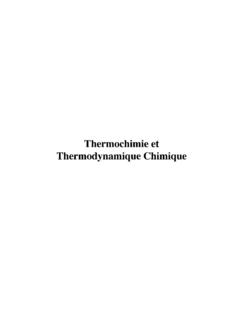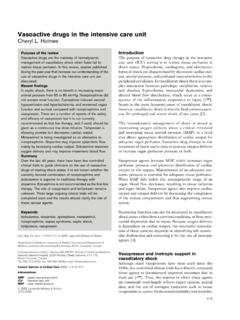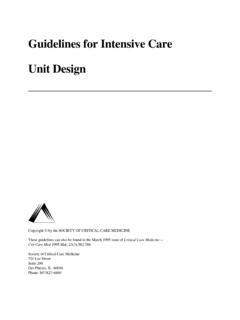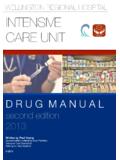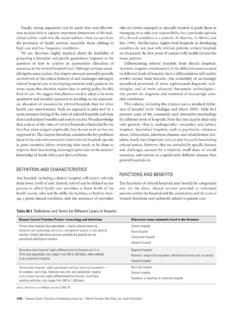Transcription of STANDARDS FOR INTENSIVE CARE UNITS - UCLouvain
1 The INTENSIVE care Society and the authors do not accept any responsibility for any loss or damage arising fromactions or decisions based on the information contained in this publication: ultimate responsibility for the treatment ofpatients and interpretation of the published material lies with the medical practitioner. The opinions expressed arethose of the authors and the inclusion in this publication of material relating to a particular product, method or tech-nique does not amount to an endorsement of its value or quality, or of the claims made by its Society wishes to acknowledge the authors of previous editions of STANDARDS for INTENSIVE care UNITS , and allthose members of the INTENSIVE care Society and their colleagues in other areas of medical and nursing practice whohave provided ideas and constructive criticism of previous Editions and of drafts of this Edition.
2 INTENSIVE care Society, May byThe INTENSIVE care SocietySTANDARDS FORINTENSIVE care UNITS 2 Guidelines on Admission to and Discharge from INTENSIVE care and High Dependency UNITS Department of Health, March 1996. INTENSIVE care High Dependency care is appropriate for: is appropriate for: Patients requiring or likely to require Patients requiring support for advanced respiratory support alone a single failing organ system, but ( IPPV).* excluding those needing advanced respiratory support.* Patients who can benefit from Patients requiring support of two more detailed observation or or more organ systems. monitoring than can safely be provided on a general ward. Patients with chronic impairment of one or more systems sufficient to Patients no longer needing restrict daily activities (co-morbidity) INTENSIVE care , but who are not and who require support for an acute yet well enough to be returned reversible failure of another organ to a general ward.
3 System.* Post-operative patients who need close observation or monitoring for longer than a few hours.. * Categories of organ system monitoring and support are shown opposite 3 Categories of Organ System Monitoring and Support Department of Health, March 1996. 1. Advanced Respiratory Support Mechanical ventilatory support excluding mask continuous positive airways pressure (CPAP) or non-invasive ( mask) ventilation. Possibility of a sudden, precipitous deterioration in respiratory function requiring immediate tracheal intubation and mechanical ventilation. 2 Basic Respiratory Monitoring and Support The need for more than 40% oxygen via fixed performance mask. The possibility of progressive deterioration to the point of needing advanced respiratory support (see above). The need for physiotherapy to clear secretions at least two-hourly, whether via a tracheostomy, a mini-tracheostomy, or in the absence of an artificial airway.
4 Patients recently extubated after a prolonged period of intubation and mechanical ventilation. Patients who are intubated to protect the airway, but needing no ventilatory support and who are otherwise stable. 3. Circulatory Support Need for vasoactive drugs to support arterial pressure or cardiac output. Support for circulatory instability due to hypovolaemia from any cause and which is unresponsive to modest volume replacement. This will include, but not be limited to, post-surgical or gastrointestinal haemorrhage or haemorrhage related to a coagulopathy. Patients resuscitated following cardiac arrest where INTENSIVE or high 4dependency care is considered appropriate. 4. Neurological Monitoring and Support Central nervous system depression, from whatever cause, sufficient to prejudice the airway and protective reflexes. Invasive neurological monitoring.
5 5. Renal Support The need for acute renal replacement therapy (haemodialysis, haemofiltration, or haemodiafiltration). 5 Contents INTRODUCTION DESIGN CONSIDERATIONS 1. Structure Health Building Note 27: INTENSIVE therapy unit Siting Size Accommodation Fire Safety 2. Services Central Services Services in Patient Areas OPERATIONAL RECOMMENDATIONS 3. Staffing Medical Staff Nursing Staff Technicians and Technical Support Other Staff 4.
6 unit administration and operational policies Clinical Management Admission and Discharge Policy Therapeutic Policies Investigational Policies Infection Control Rounds, Staff Meetings and Teaching Audit and Research 5. Management of equipment Consumables Durable Equipment APPENDICES AND REFERENCES Appendix 1: General INTENSIVE care Services: Operational Policy Appendix 2: ICNARC dataset References 7 Introduction This document is intended to apply to adult general INTENSIVE care UNITS .
7 Many parts of the document, particularly those related to structure, are applicable to other areas offering a similar degree of care , such as cardiothoracic, neurosurgical or paediatric INTENSIVE care , or high dependency care . INTENSIVE care may be broadly defined as a service for patients who have potentially recoverable conditions, who can benefit from more detailed observation and invasive treatment than can be provided safely in an ordinary ward or high dependency area. It is usually reserved for patients with threatened or established organ failure, often arising as a result or complication of an acute illness or trauma, or as a predictable phase in a planned treatment programme. INTENSIVE care represents the highest level of continuing patient care and treatment. It is distinguished from the care and treatment pertaining to a special procedure of limited duration such as a surgical operation, plasma exchange or haemodialysis, although it may embrace such procedures.
8 INTENSIVE care has, as its primary objective, the recovery of the patient to leaving hospital. The return of a patient to an intermediate care ward, such as a high dependency unit (HDU) is only the first step in this progression. INTENSIVE care involves continuing supervision, care and treatment by doctors, nurses, physiotherapists, technicians, dieticians and others. An INTENSIVE care unit (ICU) is a designated area offering facilities for the prevention, diagnosis and treatment of multiple organ failure. An ICU should have: A clear operational policy example, Appendix 1. A minimum nurse:patient ratio of 1:1, together with additional nurses according to patient needs, training requirements, the total number of beds, and the geographical arrangements within the unit . 24-hour dedicated on-site cover by medical staff. An identifiable consultant as director, supported by consultants with allocated INTENSIVE care sessions sufficient to provide continuous immediate non-resident availability.
9 The ability to support common organ system failures, in particular, ventilatory, circulatory and renal failure. A sufficient case load to maintain skills and expertise. Multidisciplinary care and effective communication. Adequate administrative, technical and secretarial support. Continuing education and training of medical and nursing staff. Audit of its activities. 8 INTENSIVE care (see p2) is appropriate for the following categories of patient: Patients requiring advanced respiratory support alone. Patients requiring support of two or more organ systems (see: Categories of Organ Support, p3). Patients with chronic impairment of one or more organ systems sufficient to restrict normal activity and who require support for an acute reversible failure of another organ system. High dependency care (see p2) is appropriate for the following categories of patient: Patients requiring support for a single failing organ system, but excluding those needing advanced respiratory support.
10 Patients requiring a level of observation or monitoring not possible on a general ward. Examples may include (but are not limited to) patients with invasive arterial pressure monitoring, central venous pressure monitoring or with a pulmonary artery catheter in situ, patients requiring epidural analgesia or intravenous opioid infusions for pain control, or patients no longer needing INTENSIVE care , but who are not yet well enough to be returned to a general ward. High dependency care requires a level of care intermediate between that available on a general ward and that on an ICU. A high dependency unit (HDU) should be able to provide monitoring and support to patients with, or at risk of developing, acute or acute-on-chronic single organ failure. It should not manage patients requiring multiple organ support or mechanical ventilation. An HDU can act as a 'step-up' or 'step-down' facility between the general ward and INTENSIVE care unit .
